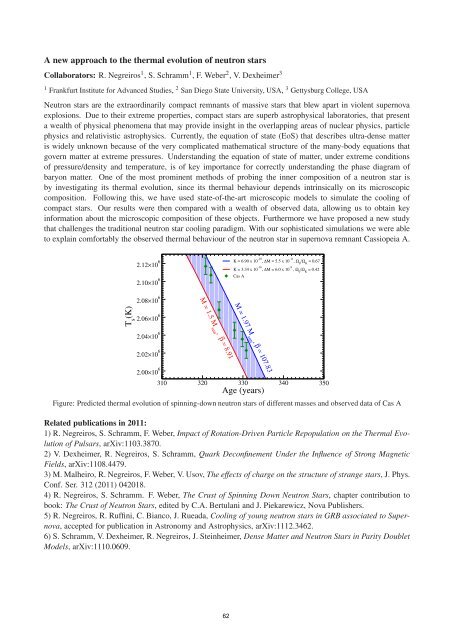FIAS Scientific Report 2011 - Frankfurt Institute for Advanced Studies ...
FIAS Scientific Report 2011 - Frankfurt Institute for Advanced Studies ...
FIAS Scientific Report 2011 - Frankfurt Institute for Advanced Studies ...
You also want an ePaper? Increase the reach of your titles
YUMPU automatically turns print PDFs into web optimized ePapers that Google loves.
A new approach to the thermal evolution of neutron stars<br />
Collaborators: R. Negreiros 1 , S. Schramm 1 , F. Weber 2 , V. Dexheimer 3<br />
1 <strong>Frankfurt</strong> <strong>Institute</strong> <strong>for</strong> <strong>Advanced</strong> <strong>Studies</strong>, 2 San Diego State University, USA, 3 Gettysburg College, USA<br />
Neutron stars are the extraordinarily compact remnants of massive stars that blew apart in violent supernova<br />
explosions. Due to their extreme properties, compact stars are superb astrophysical laboratories, that present<br />
a wealth of physical phenomena that may provide insight in the overlapping areas of nuclear physics, particle<br />
physics and relativistic astrophysics. Currently, the equation of state (EoS) that describes ultra-dense matter<br />
is widely unknown because of the very complicated mathematical structure of the many-body equations that<br />
govern matter at extreme pressures. Understanding the equation of state of matter, under extreme conditions<br />
of pressure/density and temperature, is of key importance <strong>for</strong> correctly understanding the phase diagram of<br />
baryon matter. One of the most prominent methods of probing the inner composition of a neutron star is<br />
by investigating its thermal evolution, since its thermal behaviour depends intrinsically on its microscopic<br />
composition. Following this, we have used state-of-the-art microscopic models to simulate the cooling of<br />
compact stars. Our results were then compared with a wealth of observed data, allowing us to obtain key<br />
in<strong>for</strong>mation about the microscopic composition of these objects. Furthermore we have proposed a new study<br />
that challenges the traditional neutron star cooling paradigm. With our sophisticated simulations we were able<br />
to explain com<strong>for</strong>tably the observed thermal behaviour of the neutron star in supernova remnant Cassiopeia A.<br />
T s (K)<br />
2.12×10 6<br />
2.10×10 6<br />
2.08×10 6<br />
2.06×10 6<br />
2.04×10 6<br />
2.02×10 6<br />
2.00×10 6<br />
M = 1.5 M sun , β = 8.91<br />
K = 6.90 x 10 -18 , ∆M = 5.5 x 10 -11 , Ω 0 /Ω K = 0.67<br />
K = 3.34 x 10 -16 , ∆M = 6.0 x 10 -9 , Ω 0 /Ω K = 0.42<br />
Cas A<br />
M = 1.97 M sun , β = 107.83<br />
310 320 330 340 350<br />
Age (years)<br />
Figure: Predicted thermal evolution of spinning-down neutron stars of different masses and observed data of Cas A<br />
Related publications in <strong>2011</strong>:<br />
1) R. Negreiros, S. Schramm, F. Weber, Impact of Rotation-Driven Particle Repopulation on the Thermal Evolution<br />
of Pulsars, arXiv:1103.3870.<br />
2) V. Dexheimer, R. Negreiros, S. Schramm, Quark Deconfinement Under the Influence of Strong Magnetic<br />
Fields, arXiv:1108.4479.<br />
3) M. Malheiro, R. Negreiros, F. Weber, V. Usov, The effects of charge on the structure of strange stars, J. Phys.<br />
Conf. Ser. 312 (<strong>2011</strong>) 042018.<br />
4) R. Negreiros, S. Schramm. F. Weber, The Crust of Spinning Down Neutron Stars, chapter contribution to<br />
book: The Crust of Neutron Stars, edited by C.A. Bertulani and J. Piekarewicz, Nova Publishers.<br />
5) R. Negreiros, R. Ruffini, C. Bianco, J. Rueada, Cooling of young neutron stars in GRB associated to Supernova,<br />
accepted <strong>for</strong> publication in Astronomy and Astrophysics, arXiv:1112.3462.<br />
6) S. Schramm, V. Dexheimer, R. Negreiros, J. Steinheimer, Dense Matter and Neutron Stars in Parity Doublet<br />
Models, arXiv:1110.0609.<br />
62
















